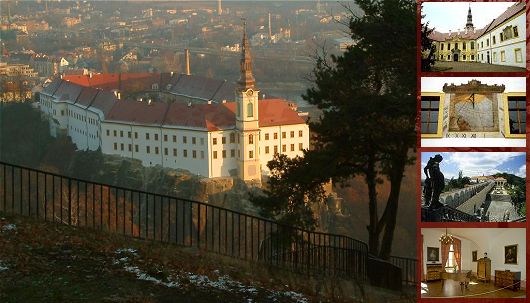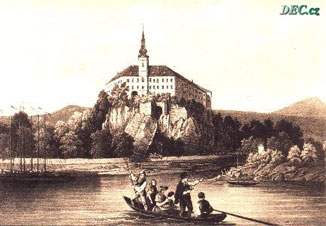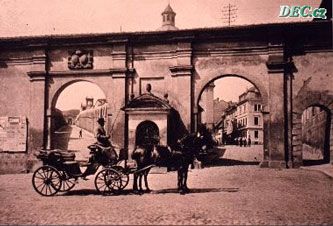Kes v pokladne zamku. Prinasi tim sice omezenou dobu mozneho odlovu, ale na druhou stranu se jen tak neztrati ... Dekujeme vedeni zamku za pomoc :-).
Staci jen slusne pozadat slecny za pultem pokladny.
EN:
Original cache GCZ12C, let it groung be light, was towards the end very often losing. Good places to hide is a little, so we have chosen this option.
Cache in the castle cash desk. Although this brings a limited time of the possible hunt, but on the other side, there will be no more loosing of it. ... Thanks for the help to management of the castle :-).
Just ask nicely the Misses behind the counter.
DE:
GCZ12C, der originale Cache, wurde sehr oft gemuggelt. An dieser Stelle gibt es nur sehr wenige gute Verstecke und so haben wir uns für diese Option entschieden!
Der Cache befindet sich in der Hauptkasse der Burg. Obwohl er nur zu den Öffnungszeiten geloggt werden kann, wird er hier so schnell nicht wieder verschwinden! Vielen herzlichen Dank an das Schlossmanagement :-).
Die Damen hinter dem Schalter an der Kasse kannst du, wenn notwendig, anständig um Hilfe bitten.
Oteviraci doby / Opening time / Öffnungszeit
listopad–unor: denne 10:00–16:00;
so, ne, svatky 10:00–17:00
brezen–cerven: denne 9:00–17:00
cervenec–srpen: denne 9:00–18:00
zari–rijen: denne 9:00–17:00

[czech]
Historie zamku: Predchudcem decinskeho zamku bylo drevene hradiste, vystavene zrejme na konci 10 st. jako operny bod ceskeho knizete pro spravu okolni oblasti, tzv. decinske provincie. Prvni pisemna zminka o teto provincii pochazi z roku 993, vlastni hradiste je poprve zmineno k roku 1128. Toto puvodni hradiste bylo ve 13. stol. prestaveno na kralovsky hrad, ktery kolem roku 1305 prechazi za nejasnych okolností do rukou mocneho rodu Vartenberku.
Presnou podobu puvodniho stredovekeho decinskeho hradu nezname. Vime vsak, ze byl rozdelen na dve casti - horni (zadni) a dolni (predni), ktere fungovaly vicemene samostatne. Tato dispozice byla zachovana az do konce 18. století.
K vyznamnejsi promene sidla doslo ve 2. pol. 16. stol., kdy byl zamek v drzeni saskeho rodu rytiru z Bünau, kteri dolni hrad postupne prestaveli na renesancni zamek. Horni hrad si ovsem podrzel svuj stredoveky charakter. Temito upravami ovsem nebyl dotcen pevnostni charakter sidla. Diky pozdejsim prestavbam se z goticke a renesancni podoby hradu dochovalo jen nekolik drobnych fragmentu.
Soucasna podoba zamku je dilem hrabeciho rodu Thun-Hohenstein, ktery drzel decinske panstvi v letech 1628-1932. Thunove pochazeli puvodne z jiznich Tyrol a postupne se vypracovali mezi predni slechticke rody habsburske monarchie. Prislusnici rodu pravidelne zastavali dulezite politicke i cirkevni urady. Napr. Lev Thun pusobil v 19. st. jako ministr kultury a vyucovani, jeho synovec Franz Thun zastaval dvakrat (v letech 1889-1896 a 1911-1915) funkci mistodrzitele v Cechach a v letech 1898 - 1899 byl dokonce predsedou rakouske vlady a soucasne i ministrem vnitra. Za sve zasluhy byl roku 1911 povysen do knizeciho stavu, ktery od te doby dedi prvorozeny syn.
Thunove nechali zamek celkem dvakrat prestavet. Prvni prestavba, barokni, je spojena se jmenem Maxmiliana z Thun-Hohenstein, cisarskeho vyslance a diplomata. Byla vedena snahou posilit reprezentacni funkci objektu. Tento dojem vytvarela predevsim impozantni pristupova cesta, tzv. Dlouha jizda, prestavene vstupni kridlo, okrasne zahrady ci novy zamecky Kostel Povyseni sv. Krize.
Druha a posledni prestavba zamku probehla v letech 1786 - 1803. Jejim provedenim byl poveren decinsky architekt Jan Vaclav Kosch, ktery se rozhodl ruznorody zamecky organismus sjednotit a dat celemu objektu kompaktni vzhled. Proto nechal strhnout starsi goticke a renesancni palace, zarovnal vsechny budovy do stejne vyse a pote je opatril jednotnou fasadou. Na strane k rece byla jako nova dominanta zamku postavena stihla hodinova vez. Zamek tak ziskal barokne-klasicistni podobu, ve ktere se zachoval az dodnes.
Prestaveny zamek se v prubehu 19. stoleti stal vyznamnym strediskem kulturního i politického zivota. Diky postaveni Thunu privital zamek celou radu prominentních hostu. Roku 1854 se zde napriklad konal diplomatický kongres panovniku Rakouska (Frantisek Josef I.), Pruska (Bedrich Vilem IV.) a Saska (Bedrich August II). Castym hostem na zamku byl i naslednik rakousko-uherskeho trunu arcivevoda Frantisek Ferdinand d'Este, ktery byl dokonce s decinskymi Thuny spriznen. Proto byly po sarajevskem atentatu jeho osirele deti, Max, Ernst a Sophie vychovany prave na decinskem zamku u sve tety Marie Chotkove, provdane Thunove.
Rod Thunu udrzoval kontakty take s mnoha prednimi vedci ci umelci - Josefem Dobrovskym, Frantiskem Palackym, malirskou rodinou Manesu atd. Zrejme nejznamejsim navstevnikem zamku byl ovsem hudebni skladatel Fryderik Chopin, ktery zde pobyval v zari roku 1835. Trvalou vzpominkou na jeho pobyt zustava valcik As-dur, op. 34, c. 1, zvany Decinsky, ktery zde Chopin poprve uvedl a pote venoval komtese Josefine Thunove.
V roce 1932 museli Thunove z financnich duvodu prodat zamek ceskoslovenskemu statu, ktery jej nechal adaptovat na kasarna. Postupne se v jeho zdech vystridala ceskoslovenska, nemecka, znovu ceskoslovenska a v letech 1968 - 1991 sovetska armada. V roce 1991 ziskalo zamek do sveho majetku mesto Decin a zacala postupna rekonstrukce zchatraleho objektu.



[English]
Castle History: Decin's Castle was originally a wooden fortress built towards the end of the 10th century as a point of support for the Bohemian princes for ruling the surrounding area, the Decin Province. The first written record of the province dates from 993 A.D. and of the fortress itself from 1128. This original structure was rebuilt in the 13th century as a royal castle which, under uncertain circumstances fell into the hands of the powerful Wartenberg dynasty around 1305.
The exact appearance of this medieval Decin Castle is not known. However, we do know that it was divided into two sections - the upper (rear) and lower (forward) parts, which each operated more or less independently. This layout was preserved until the end of the 18th century.
A significant change to the castle came in the second half of the 16th century when it was held by the Saxon dynasty of the Knights of Bunau, who gradually rebuilt the lower castle into a renaissance palace. The upper castle retained its medieval character. The renovations did not, of course, change the castle's nature as a stronghold. Due to later renovations, only fragments of the castle's gothic and renaissance incarnations survived.
The current appearance of the castle is the work of the noble family of Thun-Hohenstein, which held the Decin lands from 1628 to 1932. The Thuns originally came from southern Tyrolia and gradually worked their way to a place among the upper nobility of the Hapsburg monarchy. Sons of the family regularly filled important political and church appointments. For example, Leo Thun served as Minister of Culture and Education in the 19th century and his nephew Franz Thun twice held the function of Vice-Regent of Bohemia (1889-1896 and 1911-1915) and was even premier of the Austrian government and its Interior Minister. In reward for his service, he was knighted in 1911, a title inherited by his and every following first-born son.
The Thuns reworked the castle twice. The first reconstruction was in the baroque style, undertaken by Maximilian von Thun-Hohenstein, Imperial envoy and diplomat. It was meant to enhance the ceremonial aspects of the property. An appropriate impression of grandeur was achieved by the construction of an imposing access drive known as the the Long Drive, the reconstruction of the entry wing, ornamental gardens and a new castle church, the Church of the Ascension of the Holy Cross.
The second and final reconstruction of the castle was undertaken in 1786-1803. It was entrusted to the Decin architect Jan Vaclav Kosch, who chose to unify the diverse elements of the castle organism and give the whole complex a harmonious appearance. To do so he had the gothic and renaissance palaces torn down, levelled all structures to the same height and then covered them with a single facade. On the riverfront the castle's new dominant feature rose up, a slender clock tower. Thus the castle took on the baroque-classical appearance we see today.
In the course of the 19th century, the rebuilt castle became an important cultural and political center. As became the status of the Thuns, the castle hosted an array of prominent guests. In 1854, for example, a diplomatic congress of the rulers of Austria (Franz Joseph I), Prussia (Frederick Wilhelm IV) and Saxony (Frederick Augustus II) was held here. A regular guest at the castle was the heir to the Austro-Hungarian throne, Archduke Franz Ferdinand d'Este, who was kin to the Decin Thuns. Thus, after his and his wife's assassination in Sarajevo, his orphaned children, Max, Ernst, and Sophie, were raised here in the Decin Castle by their aunt Marie Thun (neé von Chotkowa).
The Thun family maintained contact with many leading scientists and artists - Josef Dobrovsky, Frantisek Palacky, the Manes family (painters), and others. Certainly the most famous of such visitors to the castle was the musical composer Frederick Chopin, who stayed here in September 1835. A lasting memento of his stay is the Decin Waltz (Op.34 No.1) which Chopin premiered here and dedicated to the Countess Josephine von Thun-Hohenstein.
In 1932 financial necessity obliged the Thuns to sell the castle to the Czechoslovak state, which converted it into a barracks. The castle complex served, in succession, the Czechoslovak, the German, again the Czechoslovak, and finally (1968-1991) the Soviet armies. In 1991 the castle reverted to the ownership of the city of Decin and the gradual renovation of the devastated structure began.
Text prevzat z http://www.zamekdecin.cz/
Fotografie z http://www.dec.cz/
Cache je součástí GeoTrophy.net
6.10.2012:
Po ctvrt roce zivota teto kese jsme museli konstatovat, ze je kes opravdu slusne vybrana ... nedelal jsem si iluzi, ale tohle bylo docela rychle ...
Doplnili jsme tedy opet krabici vrchovate az po oktraj novymi hrackami a vlozili pres 70 CWG ... prvnich par to mozna potesi ....
Sami si muzete udelat obrazek pri vasi navsteve, jaky bude aktualni stav ....
